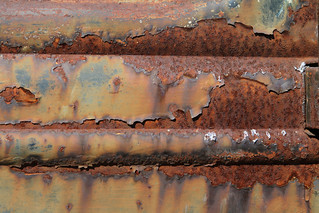
 Despite being one of the most common and useful materials for manufacturing, steel has always had one major flaw: it rusts. We often see the dark brown or red color and flaky material on old bridges, old buildings, and on steel that has been left out in the open for too long. So, why does steel rust? Which specific types of steel rust? What can be done to protect steel from rust?
Despite being one of the most common and useful materials for manufacturing, steel has always had one major flaw: it rusts. We often see the dark brown or red color and flaky material on old bridges, old buildings, and on steel that has been left out in the open for too long. So, why does steel rust? Which specific types of steel rust? What can be done to protect steel from rust?
Does Steel Rust?
Yes, steel does rust. Oxygen and water in combination cause any material made with iron to rust. Because steel is made almost entirely of iron, it is the most highly manufactured man-made material that is subject to rust.
Why Does Steel Rust?
To understand why steel rusts, you have to know a little bit about chemistry and the periodic table. Elements proceeding Helium on the periodic table aim to have 8 electrons in their outer shell, and will borrow electrons from other elements to achieve that level. Water, for example is made of an oxygen atom with 6 outer electrons and 2 hydrogen atoms that have 1 electron each. Through the borrowing and sharing of electrons in a reduction reaction, FeO(OH) (the most common form of rust) is created.
How Does Rust Form?
When any type of metal rusts, including steel, it undergoes a chemical reaction called corrosion. A variety of different types of rusts can form, but the most common form is Fe2O3. Rust only forms on the outside of a metal surface because it requires exposure of oxygen and water to rust. If you find an old metal table or steel rod that’s been left outside that you try to scrub clean of rust, anything shiny under the surface you see has not been exposed yet to both oxygen and water.
Does Steel Rust in Water?
Yes, steel does rust in water. However, it forms a different type of rust that does not develop as quickly as common rust you see on metals left outdoors – FeO(OH). Specifically, it creates iron(III) hydroxide, also known as Fe(OH)3. Steel needs both water and the oxygen from air to create FeO(OH) rust. That doesn’t mean that your boat made out of steel materials is protected from corrosion however, as only a small amount of air can cause steel to rust.
Does Steel Rust in Saltwater?
Yes, steel does rust in saltwater. In fact, steel rusts faster in saltwater than it does in freshwater. The presence of salt acts as a catalyst, accelerating the corrosion chemical reaction process. Salt is an electrolyte, and it contributes ions to water. Those who live in colder climates are well aware of the corrosive danger of salt and have to check their cars regularly during the winter for signs of rust if salt is regularly spread on their roads to combat ice. Roads, bridges, and other steel structures along roads in colder climates are also at risk of deterioration.
How Long Does it Take for Steel to Rust?
Steel will rust immediately after exposure to moisture and air. While the chemical reaction that causes steel to corrode happens instantly, it may take some time for you to notice. Visual signs of rust may appear as quickly as a week or two when exposed to the right conditions. Rusting will affect the exterior of steel first before slowly corroding through the steel surface. Given enough time, all iron in the steel material will oxidize and render the steel essentially useless for the purpose it was intended for. Luckily, that oxidation process typically takes a long time, and some rusted surfaces can be fixed.
Does Mild Steel (Carbon Steel) Rust?
Yes, mild steel, also known as carbon steel, will rust over time unless it is treated with some sort of protective coating to prevent the steel from corroding. Mild steel has a low carbon content, and the carbon does not help prevent the steel from rusting. Elements that are introduced to steel like molybdenum, titanium and chromium can improve the corrosion resistance of steel, but it does not make the steel rust-proof.
Coating to Prevent Rust
While the iron in steel is subject to the oxidation process that forms rust, providing the steel with a thin layer of material that doesn’t rust is an effective way to protect the steel from corrosion. Here are a few of the most common methods for protecting metals from corrosion.
Zinc (Galvanized Steel)
Coating steel with zinc is commonly referred to as galvanizing steel. Steel, among other metals like aluminum and iron, are immersed in 860 degree Fahrenheit zinc. The zinc reacts with oxygen and carbon dioxide to form zinc carbonate, which is seen as the exterior of many metallic objects like street lamps, I-beams, and other steel products. Not only does it give the steel a nice visual appearance, it also does an excellent job of preventing rust from forming. Of course, if the exterior surface gets scratched or worn away, then the now exposed steel will begin to corrode.
Chromium (Stainless Steel)
Coating steel with a thin layer of chromium oxide is more commonly referred to as stainless steel, and is one of the most widely manufactured corrosion-resistant steels in the world. The chromium acts mostly to prevent the oxidation process of corrosion from occurring, as it acts as a barrier to oxygen from reaching the iron of the steel. Chromium also gives the steel a clean and polished appearance that makes it practical for a wide range of applications.
Aluminum (Aluminum Steel)
Steel that is coated with aluminum-silicon alloy has more resistance to corrosion than regular steel, and also maintains the steel’s properties at extremely high temperatures. For that reason aluminum steel is often used for applications that require the material to hold up to high temperatures while not rusting over time like HVAC units, car mufflers, ovens, water heaters, and fireplaces.
How to Protect Steel From Rust
Whether you have steel tools, car parts, or a shed made of steel, they can all succumb to rusting if you don’t treat them properly. Here are a few of our favorite tips for preventing rust from forming on everyday items made from steel.
- Keep it dry – Whether you are washing your tools or you accidentally left them out in the rain, it’s best to keep them dry at all times. Dry tools after use, and store them in an enclosed space with low humidity levels if possible.
- Keep it Clean – Accumulated dirt and debris can hold moisture and allow corrosion to occur even on a dry day. Periodically using a hose or pressure washer to clean up dirty areas around metallic surfaces can help avoid rusting in the long run.
- Apply a Protective Coating – Depending on the surface you want to protect, you can apply a coating to protect your metal from rusting. Adding a layer of acrylic latex paint or oil based paint adds helps metallic objects like rain gutters from rusting, and is likely the most economical option for household items.





